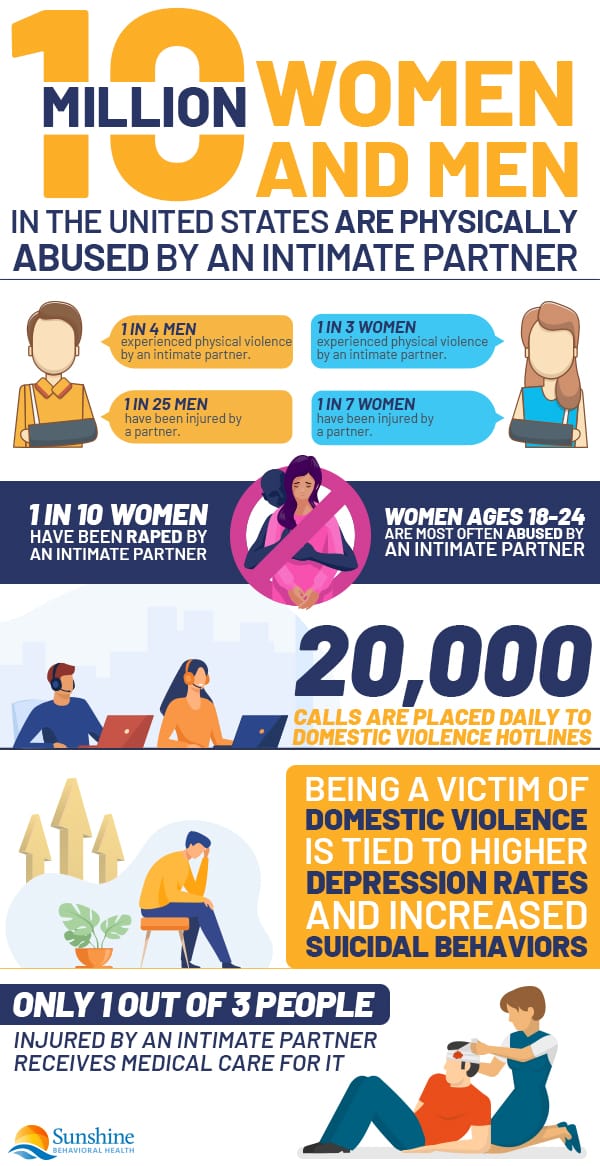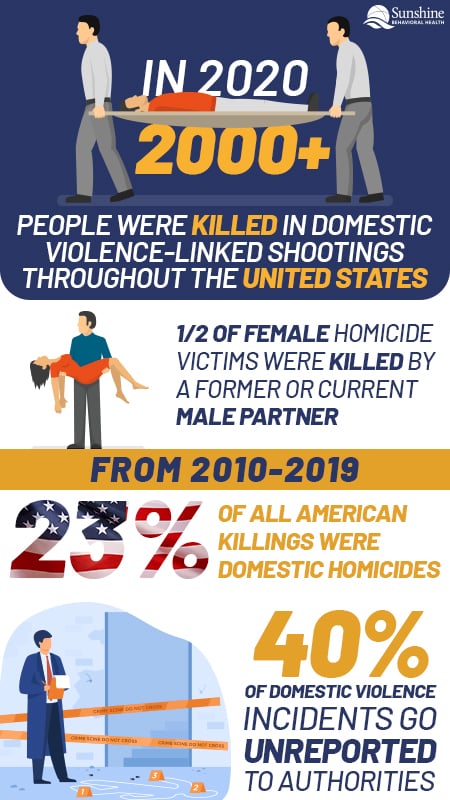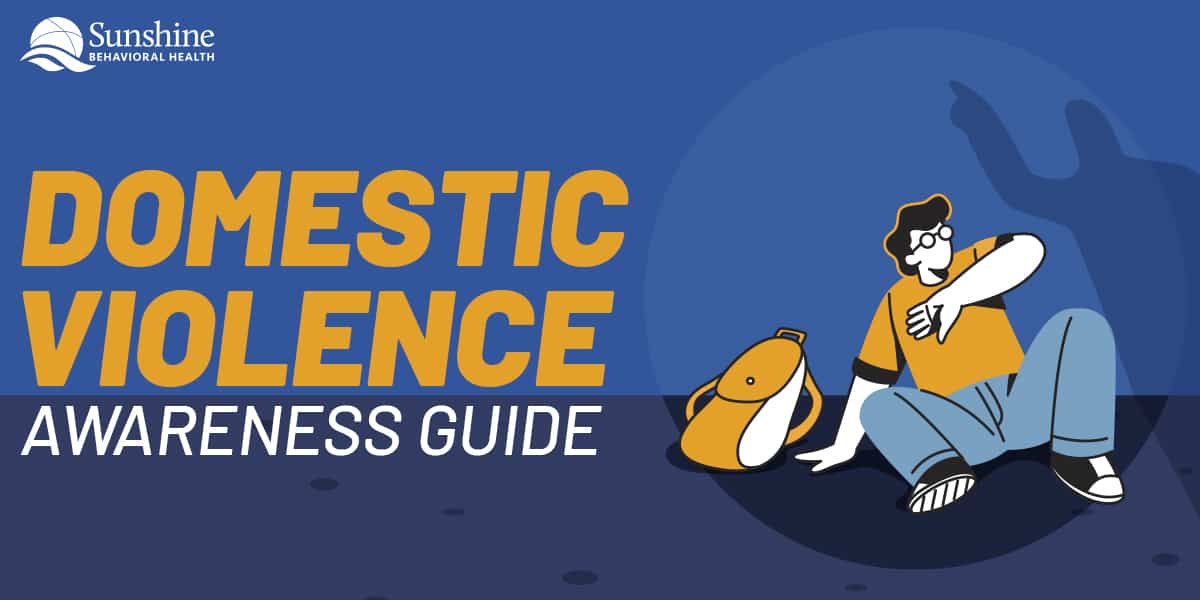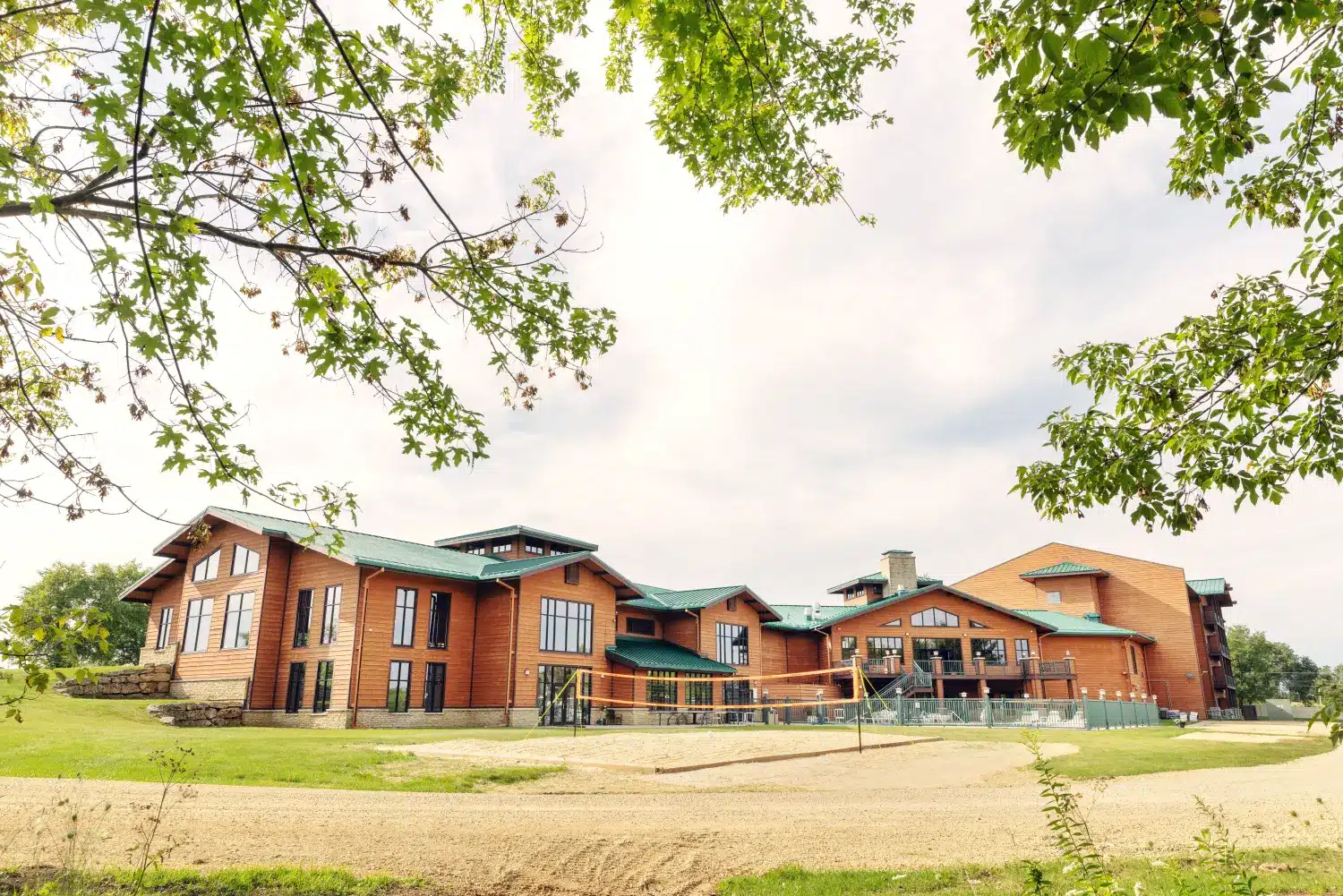Domestic violence occurs when one intimate partner abuses the other. It’s not limited to physical abuse. It can be sexual, emotional, psychological, and even economic in nature. It’s characterized by fear, intimidation, humiliation, and injuries. Anyone of any gender, race, age, culture, religion, educational level, or socioeconomic group can be a victim.
Essentially domestic abuse occurs in relationships where one partner resorts to behaviors designed to overpower and control the other.
Men are victims of domestic violence, too, but it affects women more often.
According to the National Coalition Against Domestic Violence (NCADV):
- One in three women and one in four men have been physically attacked by a partner.
- One in seven women and one in 25 men have been injured by an intimate partner.
- One in 10 women has been raped by a partner.
Also referred to as domestic abuse or intimate partner abuse, domestic violence doesn’t only hurt the victim. Children in such situations suffer. So do other loved ones.
It can also affect the victim at work, leading to sick days, reduced productivity, and even job loss. Domestic violence costs the U.S. economy an estimated $8.3 billion each year.
Types of Domestic Violence
Domestic violence can take on many forms, from slapping to insults to forcing a person to do things against their will. Types of abuse include:
- Physical – Hitting, kicking, hair-pulling, or other things that could lead to injury.
- Emotional/Psychological – Threats, destroying property or pets, belittling, name-calling, and controlling behavior.
- Financial/economic – Controlling the money and keeping the victim dependent on the abuser.
- Sexual abuse – Forcing the victim to do sexual things against their will. It could be rape, accusations of infidelity, or making someone dress provocatively.
- Stalking – Repeated and unwelcome contact that leaves the victim feeling fearful and unsafe.
Signs of Domestic Violence
Sometimes abuse begins in small or subtle ways. It could be something that makes the injured party wonder if something is going on, but they may downplay it or dismiss the behavior as an anomaly. An abuser may apologize, explain it was an accident, or say they acted out of love.
That “one time” rarely is, however. Often the abuse escalates.
Domestic abuse red flags include a partner who:
- Belittles you or mocks your accomplishments
- Intimidates or threatens you
- Says you are worthless without them
- Makes it hard for you to make decisions
- Pushes, shoves, grabs, or hits you
- Stalks or shadows you
- Blames their actions on drugs, alcohol, or you
- Forces you to do things (sexually, too) that you don’t want to do
- Makes it feel like you can never leave them
- Keeps you from spending time with others, including friends and family
Other red flags include:
- Fearing how your partner will behave
- Making frequent excuses for their behavior
- Thinking if you only change yourself then everything will be fine
- Avoiding conflict
- Doing only what they want
- Staying because you fear what they’ll do if you leave
If a person suspects a friend, co-worker, or loved one is a victim of abuse, here are some signs to look out for:
- Bruises or injuries (black eyes, red or purple marks at the neck, sprained wrists)
- Hiding bruises with makeup or clothing
- Making excuses (“I’m so clumsy”) or referring to the partner’s temper like it’s okay
- Being isolated or distant
- Asking their partner permission to do things
- Having little money
- Low self-esteem
- Being apologetic or meek
- Having a substance use disorder or substance use problems
- Depression, sadness, hopelessness
- Talking about or attempting suicide

The Cycle of Violence
Money troubles or drug and alcohol problems can raise the likelihood of abuse.
Domestic violence rarely is a one-time occurrence; it tends to escalate.
Early stages often are marked by tension. The victim may be called names or pushed around. The abuser might punch a wall. The victim rationalizes the behavior and tries to show patience.
The abuse usually grows more hostile, and more intense. The victim grows more anxious, but also sometimes more detached as the abuser gets more controlling. There can be phases of a misleading calm in between bouts of aggression. The abuser might act kind or charming for a while.
Despite that period of calm, the situation usually grows more dangerous. The abuser may also use the children as bargaining chips to keep the victim around.
Over time the victim begins to believe that the abuse is normal, or that they may even deserve it.
Breaking the Cycle
Some may think once the victim packs up and moves on that the abuse is over. That’s not always the case.
When the victim tries to escape, ends the relationship, or seeks help it’s not unusual for the abuse to intensify. That’s because the abuser is losing control over their victim so they may stalk, threaten, or harass to hold onto power.
Leaving is a dangerous time. One in five homicide victims with restraining orders was murdered within two days of getting the order. One in three are killed within the first month.
Sometimes people believe the victims choose to stay, but often they have trouble escaping. The abuser often does not stop. Law enforcement and the courts may see it as a domestic issue rather than a crime, making it harder for the victim to leave.
Who Are the Victims?
More women than men are victims of intimate partner violence. About half of the murders of women in the U.S. are due to domestic abuse. For the majority of the deaths, there was a history of brutality.
There’s no one kind of victim, however. It affects all ages. No culture, race, religion, educational level, sexual orientation, or socioeconomic status is immune.
There are some issues, apart from the signs of abuse, that show a person may have the potential to mistreat others. They include:
- Anger management problems
- Jealousy
- Poor self-esteem
- Feelings of inferiority
- A personality/psychological disorder
- Growing up in a home where domestic violence occurred (and allowed)
- Drug and alcohol use (these may fuel violent behaviors)
- Coming from a culture that believes it’s okay to control one’s partner
Why Victims Stay
In general, it’s hard to end a relationship even when abuse isn’t a factor. It does complicate things, however.
Many victims do try to leave, but even if they do that doesn’t guarantee they’re safe. There are a number of barriers to exiting a violent relationship.
Reasons people stay include:
- Conflicting emotions
- Shame
- Denial
- Fears for their or loved one’s safety
- A lack of money or other resources
- Depression
- Isolation
- Cultural or religious pressure
- Fear of losing custody of children
- Fear of being deported
A lack of support and resources is a huge roadblock.
Sometimes clergy encourage sticking together. Law enforcement may view such situations as domestic squabbles instead of a crime. Prosecutors might not want to file charges either, and restraining orders don’t always work.
Also, there often aren’t enough shelters to keep victims (who are mostly women) safe.
According to the National Network to End Domestic Violence (NNEDV), in 2020 there were 1,921 known domestic violence programs. These shelters faced unique challenges in 2020 alone, due to COVID-19.
On one day, 1,665 of those programs took part in a national count. That day there were 11,047 victim-made requests for services that were not met because not enough resources were available. Those included emergency shelter, housing, transportation, legal help, and childcare. More than half of those unmet requests were for housing and emergency shelter.
Domestic violence was considered bad before the pandemic, but incidents escalated in 2020; linked shooting deaths went up 4% nationwide from the year prior.
Victims’ Health Problems and Substance Use Disorder
Violence leads to more than bruises or broken bones. Victims can develop other problems like depression, headaches, anxiety, or post-traumatic stress disorder (PTSD).
Substance use disorder can factor heavily into domestic violence, in about half of such incidents. Sometimes it’s a precursor or a facilitator. Some victims say partners force them into alcohol or drug use. 
Victims are at higher risk of serious mental health problems and are more likely to drink heavily or use cannabis and tobacco as a result. Often it’s a way of self-medicating. That in turn can lead to risky behaviors, and raise the likelihood of physical health problems like heart disease, a weakened immune system, and many cancers. Drugs and alcohol can make mental health problems worse, too, and vice-versa (co-occurring, or dual diagnosis, disorders).
Substance use can fuel risky behaviors and lead to unplanned pregnancies. If it’s happening during pregnancy that can put the mother and developing fetus at risk of miscarriage, stillbirth, or birth defects.
What Can We Say and Do?
If domestic violence is suspected, it can bring up a lot of questions, including how to help. The best way to do that is to show compassion and kindness.
Do’s include:
- Wait for the right time and place to bring up concerns. Make sure the location is safe and private.
- Express concern. (“I’m worried someone may be hurting you.” “I’m worried that you’re not safe.”)
- Take time to listen to them.
- Tell them that they don’t deserve to be hurt, that the abuse is not their fault.
- Assure them that however they feel — scared, confused, depressed — is normal.
- Say kind things about them. Point out good qualities (strong, smart, brave, caring). Their abuser may be belittling them and their self-esteem may be low.
- Ask them what they need and how you can help. They may need a stronger support system. Link them to domestic violence resources, if they’re willing.
No matter what the victim decides, respect their decision. If they refuse help, they simply may not be ready. In the meantime, it’s not a bad idea to call a domestic violence helpline to learn more about what help is available. Staff and volunteers can answer questions and offer advice.
If the victim is willing, work on a safety plan with them.
There are a few don’ts for dealing with victims, too:
- Don’t accuse or judge the victim’s actions.
- Do not judge or criticize the abuser.
- Don’t push your friend to leave. There could be many reasons they refuse to go, including being threatened by their abuser. They may also feel they have no other options.
- Don’t assume you understand the entire situation. Instead connect your friend to people who are trained to help victims, like a local or nationwide domestic violence center.
Assessing Danger
With domestic violence shootings rising from 2019 to 2020, some states saw huge spikes in fatalities while others saw them drop. It’s not exactly clear why, since some states have more lax gun laws (Texas) and others are quite strict (Maryland.) Both Texas and Maryland, however, saw increases in domestic violence gun deaths.
Some believe the pandemic lockdowns kept the abuser and abused in closer proximity. Unemployment spikes and financial woes added tensions.
According to the National Resource Center on Domestic Violence and Firearms, the presence of a gun in the home increases the risk of domestic homicide, and gun sales did go up during the pandemic. That doesn’t explain everything, but those could be factors.
Preparing to Leave
The most dangerous time for a victim is when they’re leaving the relationship. It’s best to have as much support as possible in those early hours, days, and weeks.
When planning to leave, it’s a good idea to be prepared. Shelters and hotlines can provide advice, answer legal questions, and help track down temporary housing.
Some things to consider:
- Have a safe friend or a safe place to go. A code word is good, so you can alert friends or family you are in danger without letting the abuser know.
- Have an alternate or prepaid cell phone. Some shelters offer them, too. That can make it easier to get help or avoid being tracked by the abuser. Make sure the GPS is off. Never give information in an outgoing message.
- Memorize important numbers, like those of shelters or friends and family, just in case.
- Keep track of everything and save evidence of abuse. If you have pictures of injuries or emails or texts, save them. That can help with restraining orders or even pressing criminal charges.
- Keep important papers and records somewhere safe. An external thumb drive can be a good place to store electronic documents.
- Contact the local family or domestic violence court for help on getting personal protection or restraining order.
- Avoid online activity that can be traced by a partner. Instead, work from a friend’s computer or phone, or use the public library’s resources. If a friend posts something about you on social media, don’t let them tag you.
It’s also a good idea to have a safety plan in place, which can include emergency numbers, safe places, and alternate routes. (The National Domestic Violence Hotline’s website has advice on developing one.)
If you have a personal protection order, give copies to the school, anyone at your job (especially for security and the front desk), the babysitter, or daycare, etc.
Crisis intervention
If the batterer turns violent or threatening, there are things to do to minimize risk.
- Hide any weapons (or make them hard for the partner to access) in case of an incident
- If an argument erupts, go to a safe room. Make sure it has exits. Avoid bathrooms or closets.
- Keep a phone on you always. Hide prepaid ones for emergencies.
- Have a code word ready.
- Back your car into the driveway. Keep gas in the tank. Have a spare key hidden but easily accessible.
- If in danger, leave immediately.
- If you can’t leave, go to a safe space in the home.
- If under attack, curl into a ball and cover your head and face.
- Tell neighbors about the issue and ask them to call the cops if they see something going on.
- Teach the children not to intervene.
Breaking free of a domestic violence situation is rarely easy, but there is help. Knowing your rights, having a plan, and building a support network can be extremely useful. Life-saving, even.
If you are in danger, call 911 immediately. Otherwise, here are some resources for support, help, and more. National Suicide Prevention Lifeline. suicidepreventionlifeline.org. 800a273a8255 (TALK) Resources for Family
Sources
Medical disclaimer:
Sunshine Behavioral Health strives to help people who are facing substance abuse, addiction, mental health disorders, or a combination of these conditions. It does this by providing compassionate care and evidence-based content that addresses health, treatment, and recovery.
Licensed medical professionals review material we publish on our site. The material is not a substitute for qualified medical diagnoses, treatment, or advice. It should not be used to replace the suggestions of your personal physician or other health care professionals.







